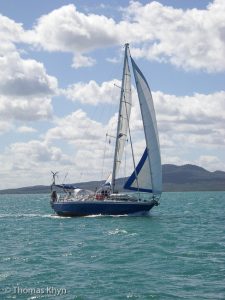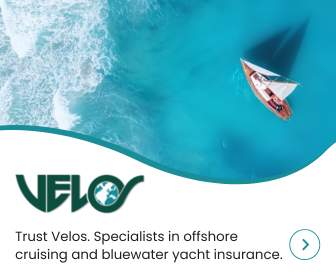Kupang, Timor: Clearing into Indonesia here
A useful report from Nicolas Remy on how the new system for clearing into Indonesia appears to be working well, and details of the necessary offices to visit in Kupang.
Published 9 years ago, updated 6 years ago


We cleared into Indonesia in Kupang, Timor, in the second half of June 2016 – therefore a month or so before the regular Sail Indonesia rally, so we were on our own to test the new clearance procedures. We’re happy to report it all went really well, despite a glitch with the advance notice.
Visas: In order to have 60 days upfront, we asked for social visas at the Indonesian Consulate in Perth, Western Australia, it cost AUD 70 per person, and it was all straightforward: in a week’s time we had our visas. The sponsor letter needed for the visa request was provided by Ms Eva Ismayanti of “Aswindo” (evaismayanti@gmail.com), which Sail Indonesia suggested we contact. They did this free of charge once we sent them the various info needed.
Advance notice: Since we were using the new procedure, the CAIT permit was no longer needed, and we didn’t need to go through an agent – thankfully, since the one we had been in contact with tried to have us ask for a CAIT anyway, which would have cost us hundreds of dollars. The next step for us was to warn the various Indonesian authorities of our impending arrival, which we did before leaving Australia. This is to be done through a single web form (https://yachters-indonesia.id/), but be aware that it does take some time to fill in, it requires some documentation to be uploaded, and in fact, leaving it to the last minute as we did might not be a great idea. When submitting the form, we repeatedly encountered an issue, which stopped us from being able to submit, so we were not able to validate the process. Supposedly, there is a “technical trick” to be able to submit the form, but we could not find it. Aswindo graciously proposed to help us by filling and submitting the form for us, and they managed to do so. In return, they provided us with the document we should have received at the end of the process, and we are very grateful for their help.
Printed documents: It is vital to have multiple copies of your various documents (registration, passports, crew list, etc.) when going to check in. Several copies of the advance notice document above are also useful, as well as a copy of the “health form” linked to during the process, and copies of your outward clearance from the previous country. When trying to print all those out, we realized we had run out of ink on the printer we have onboard, so the first thing we had to do upon arrival (after taking out cash from an ATM) was a scramble to find a printing shop which would print out our papers. In the end, we managed to find one close to the university, and if only a copy of a single document was missing, the officials would do it in their office, but we felt that they certainly would not process the clearance if we had come in with no copies at all. We had taken with us copies of the presidential decree as well as of the application memorandum that scrapped the CAIT, but none were needed at all. The officials in Kupang were all aware of the new process and the CAIT was not asked for.
Kupang anchorage: We anchored at the “usual” anchorage, off the inconspicuous Teddy’s Bar, in 6m mud and sand, good holding. The anchorage gets pretty choppy during the day, but on the whole, it was OK. There is a mosque just west of the river mouth, and it was Ramadan, but despite all this, calls to prayer were not too noisy. Getting ashore was a bit of a story, with the waves requiring quick action upon arrival, and the beach is both littered with stones, with rubbish and with some broken glass. Wheels to make it way easier to get your dinghy all the way up, which is necessary because the tidal range is quite large. The many rocks on the beach are a pain, though. We found the place to be very safe, nothing to report apart from that we actually had a good feeling of security. For three days we left the dinghy unattended (tied up, but not locked up) on the beach, and it all went well. “Agents” will greet you ashore almost every time, but they seemed clearly unofficial, meaning that they will likely guide you through the paperwork process, maybe more, but no guarantees, and I wouldn’t be comfortable handing them my passport and them disappearing for a day with it. They also offered to provide diesel fuel at a cost of 10’000 rupiah/litre on the beach in your jerrycans, but that cost seemed to vary: the other yacht there, a nicer catamaran than our boat, had been offered a price of 12’000 rupiah/litre.
Clearing in: Quarantine, Customs, and the Harbour Master are located close one to another at the Tenau Harbour, west of town, and Immigration is in a completely different location not far from the airport, east of town. Because the Harbour Master demanded paperwork from the other three to be completed first, the logical order would be to visit Immigration first, then Quarantine and Customs, and Harbour Master last. We initially got the order wrong, visiting Quarantine, Customs, and Harbour Master first, but the Harbour Master would not clear us in before Immigration had validated our entry.
- The Immigration office(Imigrasi) is located in the Penfui neighbourhood, at approximate position 10°09.8’S 123°39.0’E, but getting there with a bemo (collective mini-bus) seemed quite complicated, so a taxi is probably best. Formalities there took us barely half an hour once there, so we talked the taxi into waiting for us and then taking us directly to the harbour (“Pelabuhan Tenau”) – agree on the price beforehand, it cost us Rp 250’000 for 4 people for both trips altogether.
- Quarantine (Kesehatan Pelabuhan) is located at 10°11.52’S 123°31.73’E and the people there were friendly. They did ask me to pay Rp 250’000 for the process, and I asked for a receipt. The official provided me with a receipt for the total amount and a separate itemised list, where he suddenly realised that adding up the charges he wanted us to pay was Rp 205’000 instead, the largest item being Rp 150’000 for “boarding of the vessel”, which clearly did not take place. In the end, we paid Rp 200’000 (not having change), and we feel those fees might have been semi-official, but since he provided me with a receipt, there was nothing more I could do.
- Customs (Bea Cukai) is located at 10°11.46’S 123°31.73’E and cost us nothing (there is a large sign saying “No tipping” in their hallway), but they did want to inspect our boat, so we arranged for a meeting time back in town and we ferried two younger officials to the boat and back. They did some basic searching, were very amiable, and once they were finished greeted us with a very nice “Welcome to Indonesia”.
- The Harbour Master is located at 10°11.64’S 123°31.77’E and people were also very nice there. While we did the paperwork, they even offered us water and food (delicious !). They did charge a nominal fee, something like Rp 50’000, with a receipt, and all went fine. We were told that this office was open 24 hours and that there was no hurry to visit them upon arrival. So after we got the order wrong, we only came back the next afternoon and it was all fine. In fact, we were then able to simultaneously do the inwards international clearance and the outwards domestic clearance, because we were planning on leaving the next day. If you do stay longer than a few days, it is possible that the Harbour Master (Syahbandar) could require that you to come back later for the outwards clearance, but we don’t know.
Transportation: The most annoying thing was bemos trying to rip us off, despite us agreeing on the price before stepping in. The fare seems to be about Rp 2’000 per trip for locals, and we generally offered them Rp 5’000 for two. Generally they would be OK with it when we were hopping in to the minibus, but a few tried to charge us Rp 10’000 or even Rp 20’000 instead when we were stepping off – this seemed to be the case when at the end of the run, like at the harbour, and especially when no more locals are onboard (no witnesses…). Also, note that some bemos seemed to pass through the harbour area during the day, but not after nightfall, so after we were done with formalities there, we needed to walk back up the hill to the first little village, where bemos did come in, and we caught a ride back into town.
Shopping: Although Kupang is a large city (population 350’000), there are few western-style supermarkets. We did find an Ezra supermarket a few minutes’ walks along the main avenue heading east from the landing point, and that had some groceries and beer. Further east, with a bemo ride, we got to Lippo Plaza, at 10°09.4’S 123°36.7’E, a large mall, where we found eateries, a bakery (but the bread didn’t tempt us), a Telkomsel phone shop where we bought a SIM card and credit to get us going (3.5GB plus 12.5GB between 0 and 9 am for something like Rp 135’000), an Ace hardware store, and a Hypermart where we found plenty of groceries as well. As expected, we weren’t able to find any meat, but we were surprised to find that even frozen chickens were nowhere to be found. Another item we were surprised not to find was coconut milk! If there is anything that you really need or want, do stock up before you get to Indonesia. For fruits and vegetables, we went to the Oeba market, about a half an hour’s walk east along the coastal avenue. It was an interesting experience, we did find many greens, and we tried our bargaining in beginner Bahasa Indonesia, which did work at times.
On the whole, we had a very good first experience in Indonesia when clearing into Kupang. We haven’t called into any other port since, coastal hopping from secluded bays to remote villages instead, so we have no clue how things go elsewhere. But now the CAIT is gone, it really is worth it doing your formalities yourself.
Nicolas REMY
S/Y Fleur de Sel
Related to following destinations: Eastern Indonesia - Timor, Indonesia, Kupang


